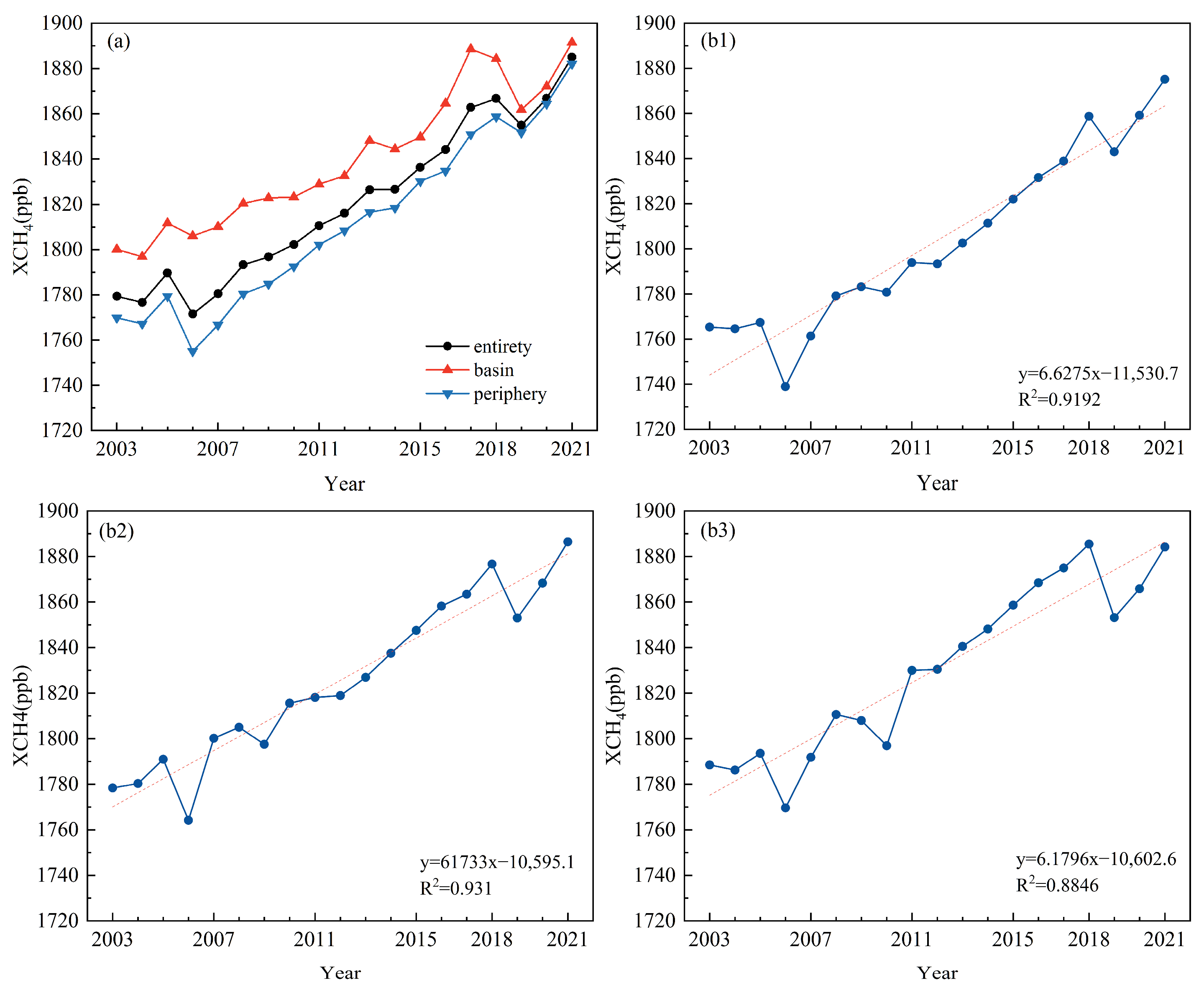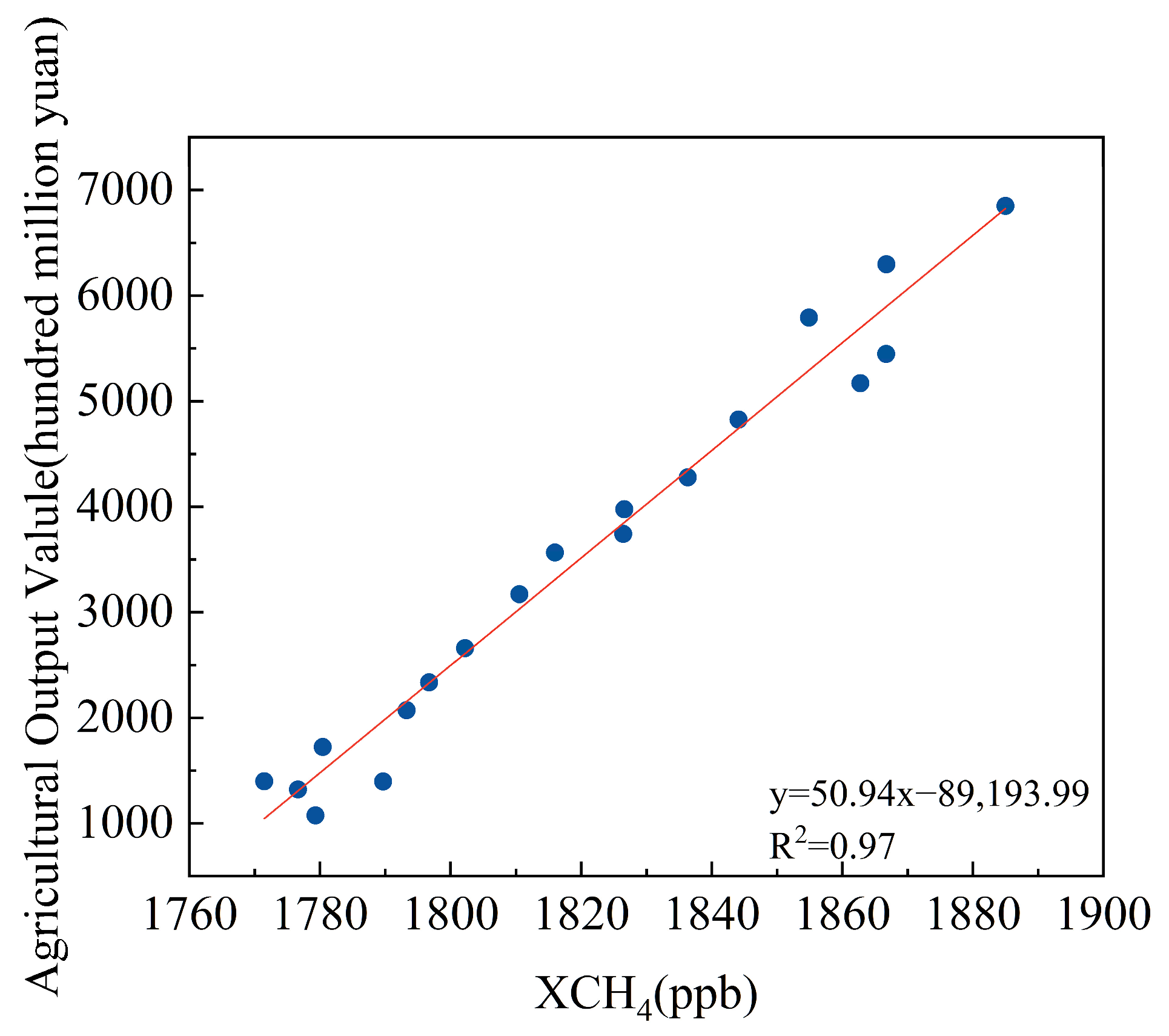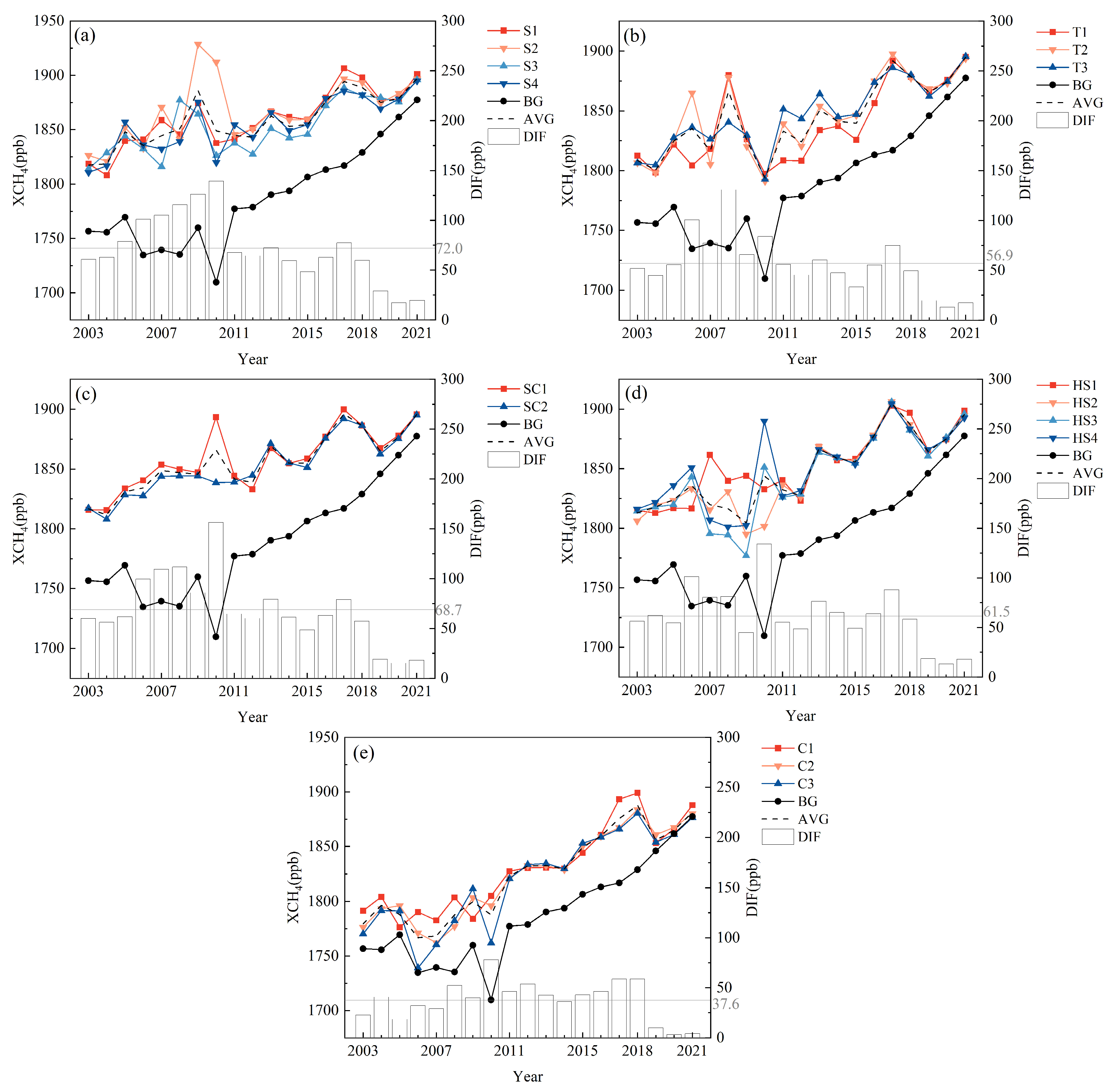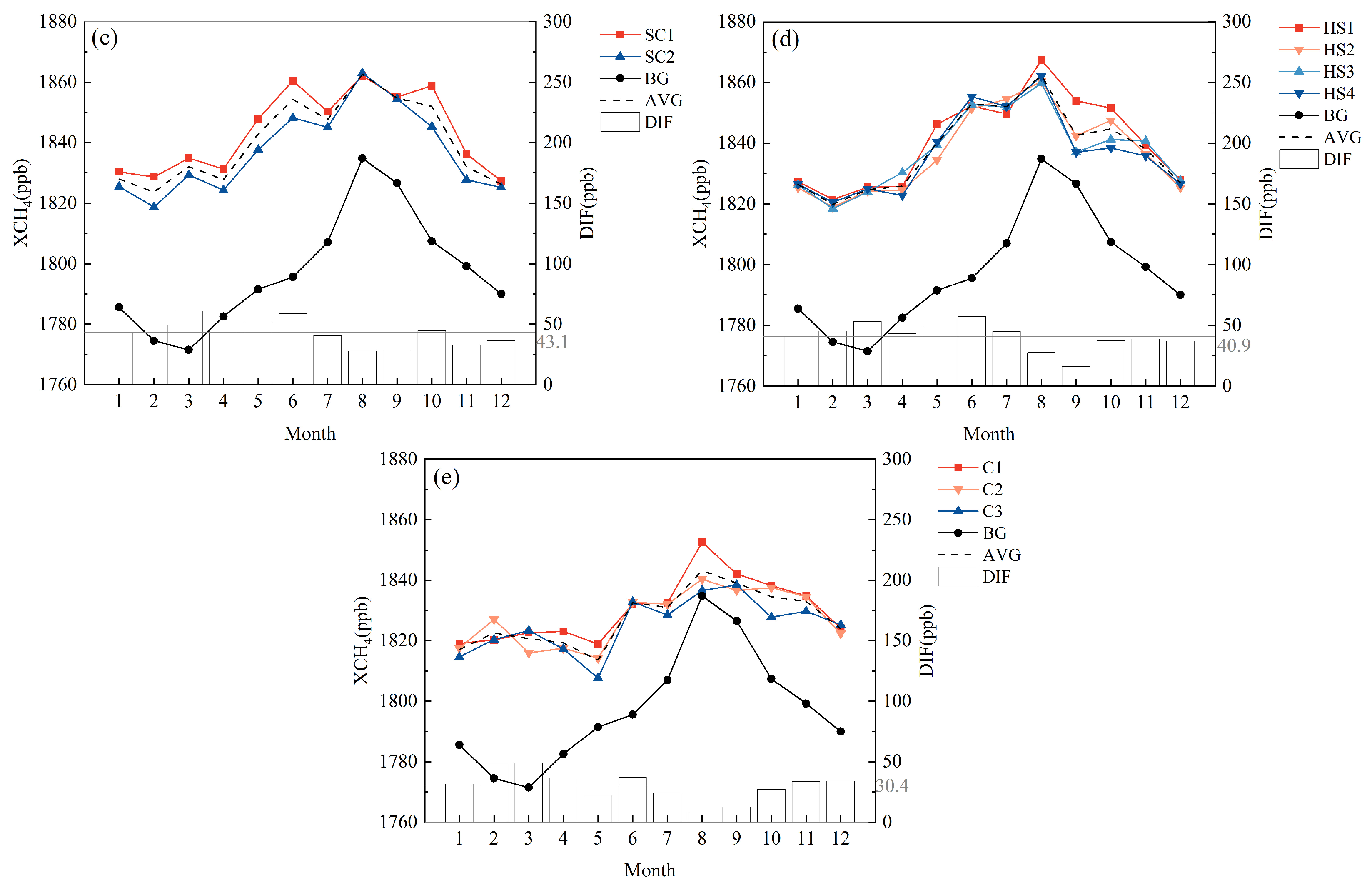XCH4 Spatiotemporal Variations in a Natural-Gas-Exploiting Basin with Intensive Agriculture Activities Using Multiple Remote Sensing Datasets: Case from Sichuan Basin, China
Abstract
1. Introduction
2. Materials and Methods
2.1. Study Area
2.2. Data
2.2.1. Satellite-Observed Methane Concentration Data
2.2.2. Ground-Level Observed Methane Concentration Data
2.2.3. Land Cover Data
2.3. Data-Processing Methods
2.3.1. Satellite Data Integration
2.3.2. Mann–Kendall Test and Theil–Sen Estimation
2.3.3. Generation of Agricultural Activity Intensity Index Assessment Model
3. Results
3.1. Validation of the Satellite Observation Data
3.2. Temporal Variation in XCH4 in the Sichuan Basin
3.3. Spatial Distribution Characteristics of XCH4 in the Sichuan Basin
3.4. Impact of Agricultural Activity on XCH4 in the Sichuan Basin
3.5. Impact of Natural Gas Exploiting on XCH4 in the Sichuan Basin
4. Discussion
- Validation and Consistency with Multi-Satellite Data
- 2.
- Spatiotemporal Patterns: Regional Uniqueness and Commonalities
- 3.
- Anthropogenic Drivers: Agriculture vs. Fossil Fuel Extraction
- 4.
- The Transport and Absorption Mechanisms of Atmospheric Methane
5. Conclusions
Author Contributions
Funding
Data Availability Statement
Acknowledgments
Conflicts of Interest
References
- Marmier, A.; Schosger, J. Methane as Greenhouse Gas; European Commission: The Hague, The Netherlands, 2020. [Google Scholar]
- Ak-Bhd, M. WMO Greenhouse Gas Bulletin; World Meteorological Organization: Geneva, Switzerland, 2021. [Google Scholar]
- Qin, J.Y.; Zhang, X.Y.; Zhang, L.J.; Cheng, M.M.; Lu, X.H. Spatiotemporal Variations of XCH4 across China during 2003–2021 Based on Observations from Multiple Satellites. Atmosphere 2022, 13, 1362. [Google Scholar] [CrossRef]
- Lelieveld, J.; Crutzen, P.J.; Dentener, F.J. Changing concentration, lifetime and climate forcing of atmospheric methane. Tellus B 1998, 50, 128–150. [Google Scholar] [CrossRef]
- Legg, S. IPCC, 2021: Climate change 2021-the physical science basis. Interaction 2021, 49, 44–45. [Google Scholar]
- He, J.; Naik, V.; Horowitz, L.W. Hydroxyl radical (OH) response to meteorological forcing and implication for the methane budget. Geophys. Res. Lett. 2021, 48, e2021GL094140. [Google Scholar] [CrossRef]
- Staniaszek, Z.; Griffiths, P.T.; Folberth, G.A.; O’Connor, F.M.; Abraham, N.L.; Archibald, A.T. The role of future anthropogenic methane emissions in air quality and climate. npj Clim. Atmos. Sci. 2022, 5, 21. [Google Scholar] [CrossRef]
- Liu, L.Y.; Chen, L.F.; Liu, Y.; Yang, D.X.; Zhang, X.Y.; Lu, N.M.; Ju, W.M.; Jiang, F.; Yin, Z.S.; Liu, G.H.; et al. Satellite remote sensing for global stocktaking: Methods, progress and perspectives. Natl. Remote Sens. Bull. 2022, 26, 243–267. [Google Scholar]
- Jin, Z.; He, J.; Wang, W. Monitoring Methane Concentrations with High Spatial Resolution over China by Using Random Forest Model. Remote Sens. 2024, 16, 2525. [Google Scholar] [CrossRef]
- Frankenberg, C.; Meirink, J.; van Weele, M.; Platt, U.; Wagner, T. Assessing methane emissions from global space-borne observations. Science 2005, 308, 1010–1014. [Google Scholar] [CrossRef]
- Gallagher, M.; Choularton, T.; Bower, K.; Stromberg, I.; Beswick, K.; Fowler, D.; Hargreaves, K. Measurements of methane fluxes on the landscape scale from a wetland area in North Scotland. Atmos. Environ. 1994, 28, 2421–2430. [Google Scholar] [CrossRef]
- Wratt, D.; Gimson, N.; Brailsford, G.; Lassey, K.; Bromley, A.; Bell, M. Estimating regional methane emissions from agriculture using aircraft measurements of concentration profiles. Atmos. Environ. 2001, 35, 497–508. [Google Scholar] [CrossRef]
- Law, A.M.; Kelton, W.D.; Kelton, W.D. Simulation Modeling and Analysis; Mcgraw-Hill: New York, NY, USA, 2007; Volume 3. [Google Scholar]
- Chen, L.; Zhang, Y.; Zou, M.; Xu, Q.; Li, L.; Li, X.; Tao, J. Overview of atmospheric CO2 remote sensing from space. J. Remote Sens. 2015, 19, 1–11. [Google Scholar]
- Aumann, H.H.; Chahine, M.T.; Gautier, C.; Goldberg, M.D.; Kalnay, E.; McMillin, L.M.; Revercomb, H.; Rosenkranz, P.W.; Smith, W.L.; Staelin, D.H. AIRS/AMSU/HSB on the Aqua mission: Design, science objectives, data products, and processing systems. IEEE Trans. Geosci. Remote Sens. 2003, 41, 253–264. [Google Scholar] [CrossRef]
- Zhang, L.; Wei, C.; Liu, H.; Jiang, H.; Lu, X.; Zhang, X.; Jiang, C. Comparison analysis of global methane concentration derived from SCIAMACHY, AIRS, and GOSAT with surface station measurements. Int. J. Remote Sens. 2021, 42, 1823–1840. [Google Scholar] [CrossRef]
- Liu, Y.; Wang, J.; Che, K.; Cai, Z.N.; Yang, D.X.; Wu, L. Satellite remote sensing of greenhouse gases: Progress and trends. Natl. Remote Sens. Bull. 2021, 25, 53–64. [Google Scholar]
- Chen, D.; Chen, A.; Hu, X.Y.; Guo, L.Y.; Yang, Y.; Fang, X.K. Historical trend of China’s CH4 concentrations and emissions during 2003–2020 based on satellite observations, and their implications. Atmos. Pollut. Res. 2022, 13, 5. [Google Scholar] [CrossRef]
- Zhang, J.X.; Han, G.; Mao, H.Q.; Pei, Z.P.; Ma, X.; Jia, W.J.; Gong, W. The Spatial and Temporal Distribution Patterns of XCH4 in China: New Observations from TROPOMI. Atmosphere 2022, 13, 177. [Google Scholar] [CrossRef]
- Feng, D.; Gao, X.; Yang, L.; Hui, X.; Zhou, Y. Analysis of long-term (2003–2015) spatial-temporal distribution of atmospheric methane in the troposphere over the Qinghai-Xizang Plateau based on AIRS data. Theor. Appl. Climatol. 2019, 137, 1247–1255. [Google Scholar] [CrossRef]
- Ehret, G.; Bousquet, P.; Pierangelo, C.; Alpers, M.; Millet, B.; Abshire, J.B.; Bovensmann, H.; Burrows, J.P.; Chevallier, F.; Ciais, P.; et al. MERLIN: A French-German space lidar mission dedicated to atmospheric methane. Remote Sens. 2017, 9, 1052. [Google Scholar] [CrossRef]
- Jiang, S.; Peng, Y.; Gao, B.; Zhang, J.; Cai, D.; Xue, G.; Bao, S.; Xu, Z.; Tang, X.; Dahdah, N. Geology and shale gas resource potentials in the Sichuan Basin, China. Energy Explor. Exploit. 2016, 34, 689–710. [Google Scholar] [CrossRef]
- Zhao, W.; Wang, Z.; Jiang, H.; Fu, X.; Xie, W.; Xu, A.; Shen, A.; Shi, S.; Huang, S.; Jiang, Q. Exploration status of the deep Sinian strata in the Sichuan Basin: Formation conditions of old giant carbonate oil/gas fields. Nat. Gas Ind. B 2020, 7, 462–472. [Google Scholar] [CrossRef]
- Zhang, D.; Dong, H. Understanding Arable Land Change Patterns and Driving Forces in Major Grain-Producing Areas: A Case Study of Sichuan Province Using the PLUS Model. Land 2023, 12, 1443. [Google Scholar] [CrossRef]
- Bovensmann, H.; Buchwitz, M.; Frerick, J.; Hoogeveen, R.W.; Kleipool, Q.; Lichtenberg, G.; Noël, S.; Richter, A.; Rozanov, A.; Rozanov, V.V. SCIAMACHY on ENVISAT: In-flight optical performance and first results. In Proceedings of the Remote Sensing of Clouds and the Atmosphere VIII, Barcelona, Spain, 16 February 2004; pp. 160–173. [Google Scholar]
- Bovensmann, H.; Burrows, J.P.; Buchwitz, M.; Frerick, J.; Noël, S.; Rozanov, V.V.; Chance, K.V.; Goede, A.P.H. SCIAMACHY: Mission objectives and measurement modes. J. Atmos. Sci. 1999, 56, 127–150. [Google Scholar] [CrossRef]
- Yokota, T.; Yoshida, Y.; Eguchi, N.; Ota, Y.; Tanaka, T.; Watanabe, H.; Maksyutov, S.J.S. Global concentrations of CO2 and CH4 retrieved from GOSAT: First preliminary results. Sola 2009, 5, 160–163. [Google Scholar] [CrossRef]
- Yokota, T.; Oguma, H.; Morino, I.; Higurashi, A.; Aoki, T.; Inoue, G. Test measurements by a BBM of the nadir-looking SWIR FTS aboard GOSAT to monitor CO2 column density from space. In Proceedings of the Passive Opl Remote Sensing of the Atmosphere and Clouds IV, Honolulu, HI, USA, 30 December 2004; pp. 182–188. [Google Scholar]
- Hamazaki, T.; Kaneko, Y.; Kuze, A.; Suto, H. Greenhouse gases observation from space with TANSO-FTS on GOSAT. In Proceedings of the Fourier Transform Spectroscopy, Santa Fe, NM, USA, 11–15 February 2007; p. FWB1. [Google Scholar]
- Veefkind, J.P.; Aben, I.; McMullan, K.; Förster, H.; de Vries, J.; Otter, G.; Claas, J.; Eskes, H.J.; de Haan, J.F.; Kleipool, Q.; et al. TROPOMI on the ESA Sentinel-5 Precursor: A GMES mission for global observations of the atmospheric composition for climate, air quality and ozone layer applications. Remote Sens. Environ. 2012, 120, 70–83. [Google Scholar] [CrossRef]
- Tucker, C.J.; Newcomb, W.W.; Los, S.O.; Prince, S.D. Mean and Inter-Year Variation of Growing-Season Normalized Difference Vegetation Index for The Sahel 1981–1989. Int. J. Remote Sens. 1991, 12, 1133–1135. [Google Scholar] [CrossRef]
- Lunetta, R.S.; Knight, J.F.; Ediriwickrema, J.; Lyon, J.G.; Worthy, L.D. Land-cover change detection using multi-temporal MODIS NDVI data. In Geospatial Information Handbook for Water Resources and Watershed Management; CRC Press: Boca Raton, FL, USA, 2022; Volume II, pp. 65–88. [Google Scholar]
- Cai, B.; Yu, R. Advance and evaluation in the long time series vegetation trends research based on remote sensing. J. Remote Sens. 2009, 13, 1170–1186. [Google Scholar]
- Xu, Z.X.; Takeuchi, K.; Ishidaira, H. Monotonic trend and step changes in Japanese precipitation. J. Hydrol. 2003, 279, 144–150. [Google Scholar] [CrossRef]
- Wu, X.D.; Zhang, X.Y.; Chuai, X.W.; Huang, X.J.; Wang, Z. Long-Term Trends of Atmospheric CH4 Concentration across China from 2002 to 2016. Remote Sens. 2019, 11, 538. [Google Scholar] [CrossRef]
- Li, L.; Zhu, L.Q.; Zhu, W.B.; Xu, S.B.; Li, Y.H.; Ma, H. The correlation between ecosystem service value and human activity intensity and its trade-offs—Take Qihe River basin forexample. China Environ. Sci. 2020, 40, 365–374. [Google Scholar]
- Xu, J.; Li, W.; Xie, H.; Wang, Y.; Wang, L.; Hu, F. Long-term trends and spatiotemporal variations in atmospheric XCH4 over China utilizing satellite observations. Atmosphere 2022, 13, 525. [Google Scholar] [CrossRef]
- Kirschke, S.; Bousquet, P.; Ciais, P.; Saunois, M.; Canadell, J.G.; Dlugokencky, E.J.; Bergamaschi, P.; Bergmann, D.; Blake, D.R.; Bruhwiler, L.; et al. Three decades of global methane sources and sinks. Nat. Geosci. 2013, 6, 813–823. [Google Scholar] [CrossRef]
- Schaefer, H.; Fletcher, S.E.M.; Veidt, C.; Lassey, K.R.; Brailsford, G.W.; Bromley, T.M.; Dlugokencky, E.J.; Michel, S.E.; Miller, J.B.; Levin, I.; et al. A 21st-century shift from fossil-fuel to biogenic methane emissions indicated by 13CH4. Science 2016, 352, 80–84. [Google Scholar] [CrossRef]
- Turner, A.J.; Frankenbergb, C.; Wennberg, P.O.; Jacob, D.J. Ambiguity in the causes for decadal trends in atmospheric methane and hydroxyl. Proc. Natl. Acad. Sci. USA 2017, 114, 5367–5372. [Google Scholar] [CrossRef]
- McNorton, J.; Chipperfield, M.P.; Gloor, M.; Wilson, C.; Feng, W.H.; Hayman, G.D.; Rigby, M.; Krummel, P.B.; O’Doherty, S.; Prinn, R.G.; et al. Role of OH variability in the stalling of the global atmospheric CH4 growth rate from 1999 to 2006. Atmos. Chem. Phys. 2016, 16, 7943–7956. [Google Scholar] [CrossRef]
- Wang, H.; Li, J.; Zhang, Y.; Li, S.; Zhang, L.; Chen, L. Spatial and temporal distribution of near-surface methane concentration over China based on AIRS observations. J. Remote Sens. 2015, 19, 827–835. [Google Scholar]
- Li, M.; Liu, S.; Sun, Y.; Liu, Y. Agriculture and animal husbandry increased carbon footprint on the Qinghai-Tibet Plateau during past three decades. J. Clean. Prod. 2021, 278, 123963. [Google Scholar] [CrossRef]
- Liu, Z.; Chen, B.; Wang, S.; Xu, X.; Chen, H.; Liu, X.; He, J.-S.; Wang, J.; Wang, J.; Chen, J. More enhanced non-growing season methane exchanges under warming on the Qinghai-Tibetan Plateau. Sci. Total Environ. 2024, 917, 170438. [Google Scholar] [CrossRef] [PubMed]
- Jin, H.; Wu, J.; Cheng, G.; Nakano, T.; Sun, G. Methane emissions from wetlands on the Qinghai-Tibet Plateau. Chin. Sci. Bull. 1999, 44, 2282–2286. [Google Scholar] [CrossRef]
- Yue, Q.; Zhang, G.J.; Wang, Z. Preliminary estimation of methane emission and its distribution in China. Geogr. Res. 2012, 31, 1559–1570. [Google Scholar]
- He, Q.; Yu, T.; Gu, X.F.; Cheng, T.H.; Zhang, Y.; Xie, D.H. Global Atmospheric Methane Variation and Temporal-Spatial Distribution Analysis Based on Ground-based and Satellite Data. Remote Sens. Inf. 2012, 27, 34–39+43. [Google Scholar]
- Sarg, J. The sequence stratigraphy, sedimentology, and economic importance of evaporite–carbonate transitions: A review. Sediment. Geol. 2001, 140, 9–34. [Google Scholar] [CrossRef]
- Zhang, D. Development prospect of natural gas industry in the Sichuan Basin in the next decade. Nat. Gas Ind. B 2022, 9, 119–131. [Google Scholar] [CrossRef]
- Dai, J.X.; Ni, Y.Y.; Liu, Q.Y.; Wu, X.Q.; Gong, D.Y.; Hong, F.; Zhang, Y.L.; Liao, F.R.; Yan, Z.M.; Li, H.W. Sichuan super gas basin in southwest China. Pet. Explor. Dev. 2021, 48, 1251–1259. [Google Scholar] [CrossRef]
- Vermeulen, A.; Eisma, R.; Hensen, A.; Slanina, J. Transport model calculations of NW-European methane emissions. Environ. Sci. Policy 1999, 2, 315–324. [Google Scholar] [CrossRef]
- Tang, J.H.; Bao, Z.Y.; Xiang, W.; Gou, Q.H. Geological emission of methane from the Yakela condensed oil/gas field in Talimu Basin, Xinjiang, China. J. Environ. Sci. 2008, 20, 1055–1062. [Google Scholar] [CrossRef] [PubMed]
- Ma, X.; Zheng, G.; Liang, S.; Fan, C.; Wang, Z.; Liang, M. Contributions of geologic methane to atmospheric methane sources and sinks. Bull. Mineral. Petrol. Geochem. 2012, 31, 139–145. [Google Scholar]




















| Satellites | Regression | R2 | R | p | N |
|---|---|---|---|---|---|
| Envisat | y = 0.73x + 418.34 | 0.05 | 0.22 | <0.01 | 96 |
| GOSAT | y = 1.13x − 336.24 | 0.64 | 0.80 | <0.01 | 96 |
| Sentinel-5P | y = 1.02x − 142.76 | 0.73 | 0.85 | <0.01 | 36 |
| Season | Total (ppb) | SCIAMACHY (ppb) | GOSAT (ppb) | TROPOMI (ppb) |
|---|---|---|---|---|
| spring | 1810.02 | 1772.40 | 1829.76 | 1857.69 |
| summer | 1832.04 | 1805.95 | 1843.12 | 1872.07 |
| autumn | 1832.21 | 1792.67 | 1854.35 | 1878.62 |
| winter | 1810.00 | 1775.59 | 1827.22 | 1857.72 |
Disclaimer/Publisher’s Note: The statements, opinions and data contained in all publications are solely those of the individual author(s) and contributor(s) and not of MDPI and/or the editor(s). MDPI and/or the editor(s) disclaim responsibility for any injury to people or property resulting from any ideas, methods, instructions or products referred to in the content. |
© 2025 by the authors. Licensee MDPI, Basel, Switzerland. This article is an open access article distributed under the terms and conditions of the Creative Commons Attribution (CC BY) license (https://creativecommons.org/licenses/by/4.0/).
Share and Cite
Wang, T.; Wang, Y. XCH4 Spatiotemporal Variations in a Natural-Gas-Exploiting Basin with Intensive Agriculture Activities Using Multiple Remote Sensing Datasets: Case from Sichuan Basin, China. Remote Sens. 2025, 17, 2695. https://doi.org/10.3390/rs17152695
Wang T, Wang Y. XCH4 Spatiotemporal Variations in a Natural-Gas-Exploiting Basin with Intensive Agriculture Activities Using Multiple Remote Sensing Datasets: Case from Sichuan Basin, China. Remote Sensing. 2025; 17(15):2695. https://doi.org/10.3390/rs17152695
Chicago/Turabian StyleWang, Tengnan, and Yunpeng Wang. 2025. "XCH4 Spatiotemporal Variations in a Natural-Gas-Exploiting Basin with Intensive Agriculture Activities Using Multiple Remote Sensing Datasets: Case from Sichuan Basin, China" Remote Sensing 17, no. 15: 2695. https://doi.org/10.3390/rs17152695
APA StyleWang, T., & Wang, Y. (2025). XCH4 Spatiotemporal Variations in a Natural-Gas-Exploiting Basin with Intensive Agriculture Activities Using Multiple Remote Sensing Datasets: Case from Sichuan Basin, China. Remote Sensing, 17(15), 2695. https://doi.org/10.3390/rs17152695






